change time Alfa Romeo 147 2010 Owner handbook (in English)
[x] Cancel search | Manufacturer: ALFA ROMEO, Model Year: 2010, Model line: 147, Model: Alfa Romeo 147 2010Pages: 291, PDF Size: 5.52 MB
Page 7 of 291
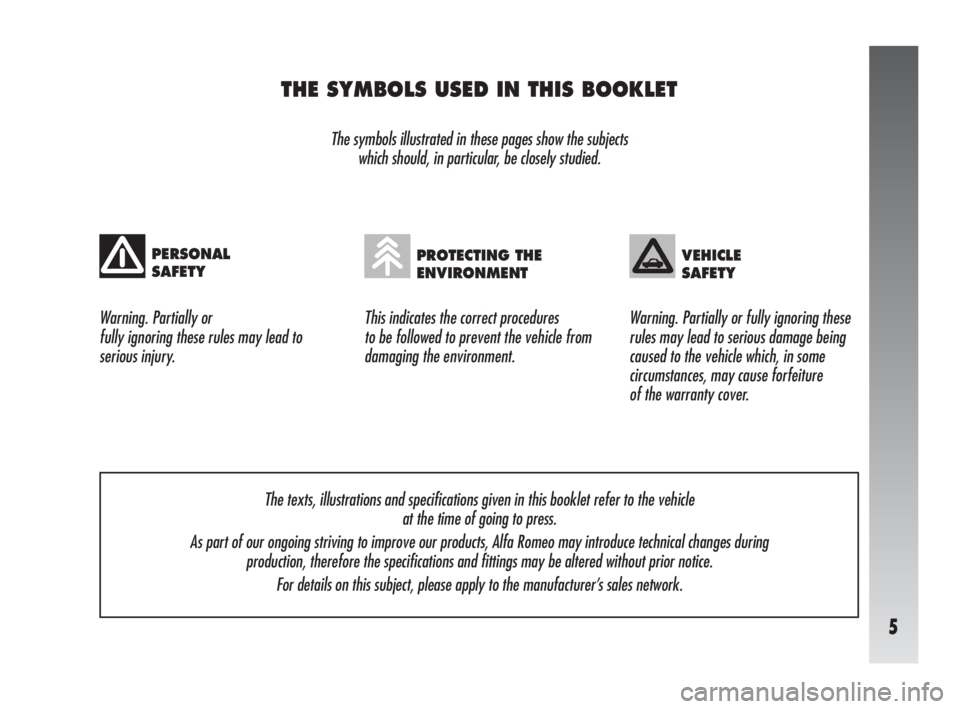
5
THE SYMBOLS USED IN THIS BOOKLET
The symbols illustrated in these pages show the subjects
which should, in particular, be closely studied.
This indicates the correct procedures
to be followed to prevent the vehicle from
damaging the environment. Warning. Partially or
fully ignoring these rules may lead to
serious injury.Warning. Partially or fully ignoring these
rules may lead to serious damage being
caused to the vehicle which, in some
circumstances, may cause forfeiture
of the warranty cover.
PERSONAL
SAFETYPROTECTING THE
ENVIRONMENTVEHICLE
SAFETY
The texts, illustrations and specifications given in this booklet refer to the vehicle
at the time of going to press.
As part of our ongoing striving to improve our products, Alfa Romeo may introduce technical changes during
production, therefore the specifications and fittings may be altered without prior notice.
For details on this subject, please apply to the manufacturer’s sales network.
Page 9 of 291
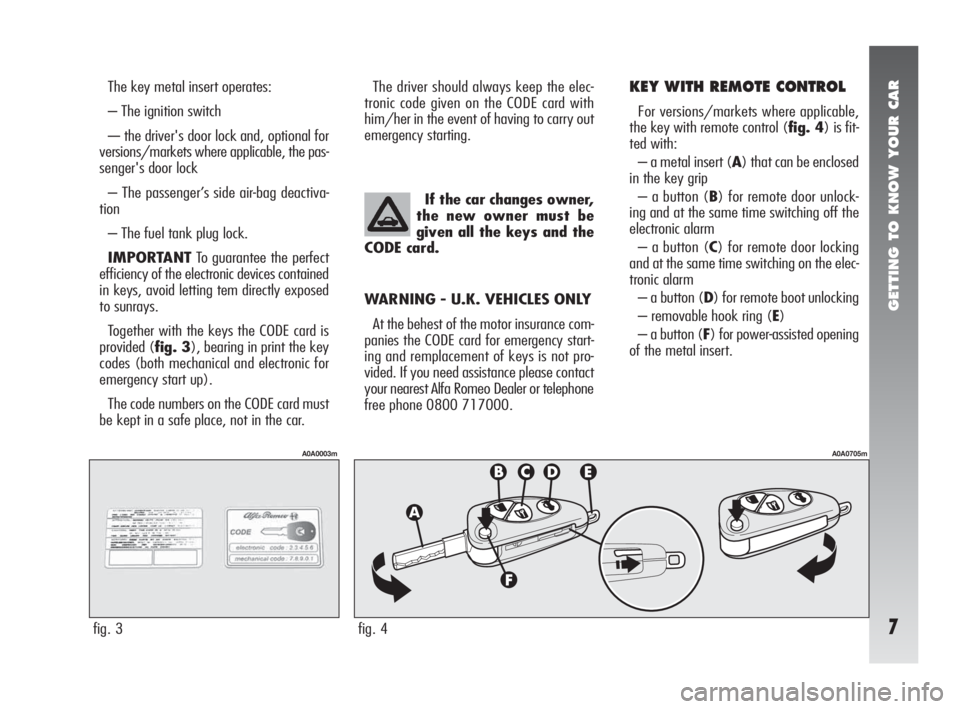
GETTING TO KNOW YOUR CAR
7
The key metal insert operates:
– The ignition switch
-– the driver's door lock and, optional for
versions/markets where applicable, the pas-
senger's door lock
– The passenger’s side air-bag deactiva-
tion
– The fuel tank plug lock.
IMPORTANTTo guarantee the perfect
efficiency of the electronic devices contained
in keys, avoid letting tem directly exposed
to sunrays.
Together with the keys the CODE card is
provided (fig. 3), bearing in print the key
codes (both mechanical and electronic for
emergency start up).
The code numbers on the CODE card must
be kept in a safe place, not in the car.The driver should always keep the elec-
tronic code given on the CODE card with
him/her in the event of having to carry out
emergency starting.
WARNING - U.K. VEHICLES ONLY
At the behest of the motor insurance com-
panies the CODE card for emergency start-
ing and remplacement of keys is not pro-
vided. If you need assistance please contact
your nearest Alfa Romeo Dealer or telephone
free phone 0800 717000.If the car changes owner,
the new owner must be
given all the keys and the
CODE card.KEY WITH REMOTE CONTROL
For versions/markets where applicable,
the key with remote control (fig. 4) is fit-
ted with:
– a metal insert (A) that can be enclosed
in the key grip
– a button (B) for remote door unlock-
ing and at the same time switching off the
electronic alarm
– a button (C) for remote door locking
and at the same time switching on the elec-
tronic alarm
– a button (D) for remote boot unlocking
– removable hook ring (E)
– a button (F) for power-assisted opening
of the metal insert.
fig. 3
A0A0003m
fig. 4
A0A0705m
Page 45 of 291
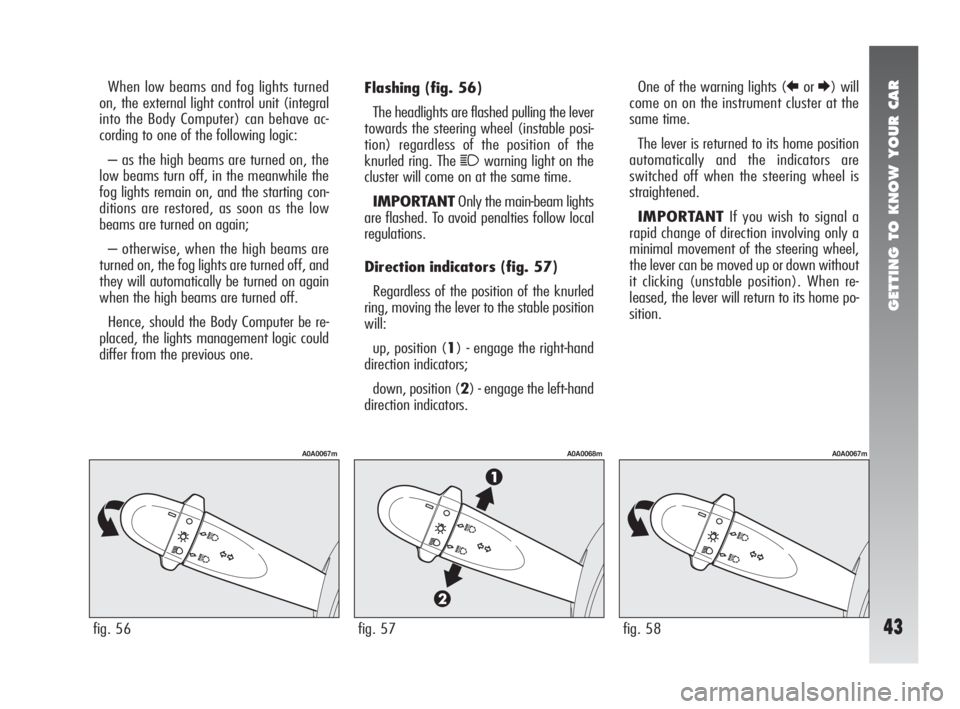
GETTING TO KNOW YOUR CAR
43
Flashing(fig. 56)
The headlights are flashed pulling the lever
towards the steering wheel (instable posi-
tion) regardless of the position of the
knurled ring. The
1warning light on the
cluster will come on at the same time.
IMPORTANTOnly the main-beam lights
are flashed. To avoid penalties follow local
regulations.
Direction indicators (fig. 57)
Regardless of the position of the knurled
ring, moving the lever to the stable position
will:
up, position (1) - engage the right-hand
direction indicators;
down, position (2) - engage the left-hand
direction indicators.One of the warning lights (
RorE) will
come on on the instrument cluster at the
same time.
The lever is returned to its home position
automatically and the indicators are
switched off when the steering wheel is
straightened.
IMPORTANTIf you wish to signal a
rapid change of direction involving only a
minimal movement of the steering wheel,
the lever can be moved up or down without
it clicking (unstable position). When re-
leased, the lever will return to its home po-
sition. When low beams and fog lights turned
on, the external light control unit (integral
into the Body Computer) can behave ac-
cording to one of the following logic:
– as the high beams are turned on, the
low beams turn off, in the meanwhile the
fog lights remain on, and the starting con-
ditions are restored, as soon as the low
beams are turned on again;
– otherwise, when the high beams are
turned on, the fog lights are turned off, and
they will automatically be turned on again
when the high beams are turned off.
Hence, should the Body Computer be re-
placed, the lights management logic could
differ from the previous one.
fig. 56
A0A0067m
fig. 58
A0A0067m
fig. 57
A0A0068m
Page 47 of 291
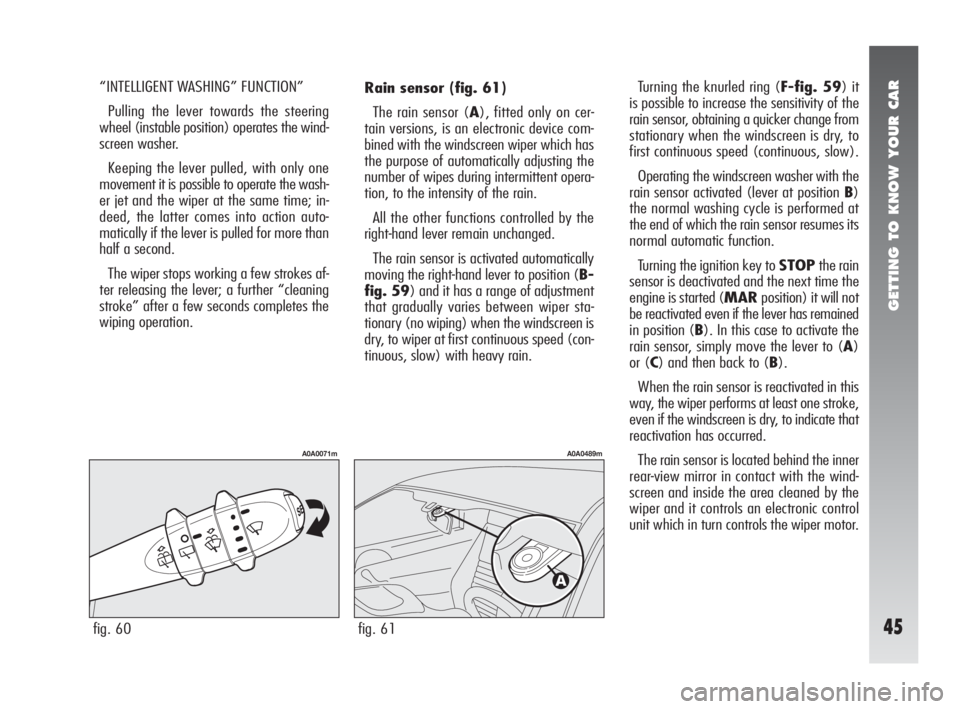
GETTING TO KNOW YOUR CAR
45
Rain sensor (fig. 61)
The rain sensor (A), fitted only on cer-
tain versions, is an electronic device com-
bined with the windscreen wiper which has
the purpose of automatically adjusting the
number of wipes during intermittent opera-
tion, to the intensity of the rain.
All the other functions controlled by the
right-hand lever remain unchanged.
The rain sensor is activated automatically
moving the right-hand lever to position (B-
fig. 59) and it has a range of adjustment
that gradually varies between wiper sta-
tionary (no wiping) when the windscreen is
dry, to wiper at first continuous speed (con-
tinuous, slow) with heavy rain.Turning the knurled ring (F-fig. 59) it
is possible to increase the sensitivity of the
rain sensor, obtaining a quicker change from
stationary when the windscreen is dry, to
first continuous speed (continuous, slow).
Operating the windscreen washer with the
rain sensor activated (lever at position B)
the normal washing cycle is performed at
the end of which the rain sensor resumes its
normal automatic function.
Turning the ignition key to STOPthe rain
sensor is deactivated and the next time the
engine is started (MARposition) it will not
be reactivated even if the lever has remained
in position (B). In this case to activate the
rain sensor, simply move the lever to (A)
or (C) and then back to (B).
When the rain sensor is reactivated in this
way, the wiper performs at least one stroke,
even if the windscreen is dry, to indicate that
reactivation has occurred.
The rain sensor is located behind the inner
rear-view mirror in contact with the wind-
screen and inside the area cleaned by the
wiper and it controls an electronic control
unit which in turn controls the wiper motor. “INTELLIGENT WASHING” FUNCTION”
Pulling the lever towards the steering
wheel (instable position) operates the wind-
screen washer.
Keeping the lever pulled, with only one
movement it is possible to operate the wash-
er jet and the wiper at the same time; in-
deed, the latter comes into action auto-
matically if the lever is pulled for more than
half a second.
The wiper stops working a few strokes af-
ter releasing the lever; a further “cleaning
stroke” after a few seconds completes the
wiping operation.
fig. 60
A0A0071m
fig. 61
A0A0489m
Page 49 of 291
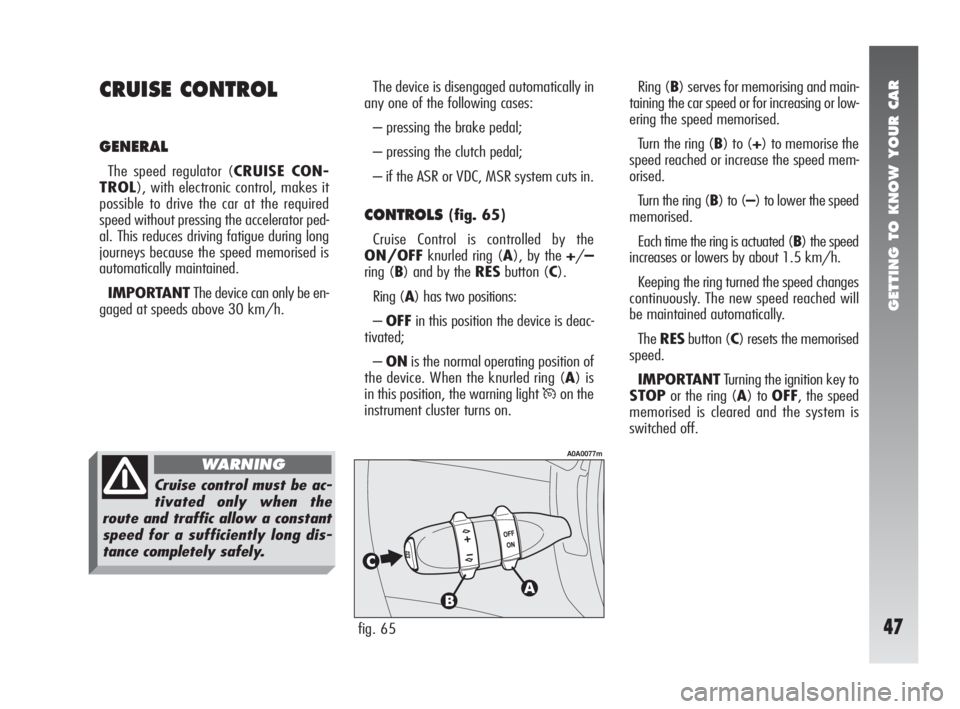
GETTING TO KNOW YOUR CAR
47
The device is disengaged automatically in
any one of the following cases:
– pressing the brake pedal;
– pressing the clutch pedal;
– if the ASR or VDC, MSR system cuts in.
CONTROLS(fig. 65)
Cruise Control is controlled by the
ON/OFFknurled ring (A), by the +/–
ring (B) and by the RESbutton (C).
Ring (A) has two positions:
–OFFin this position the device is deac-
tivated;
–ONis the normal operating position of
the device. When the knurled ring (A) is
in this position, the warning light
Üon the
instrument cluster turns on.Ring (B) serves for memorising and main-
taining the car speed or for increasing or low-
ering the speed memorised.
Turn the ring (B) to (+) to memorise the
speed reached or increase the speed mem-
orised.
Turn the ring (B) to (–) to lower the speed
memorised.
Each time the ring is actuated (B) the speed
increases or lowers by about 1.5 km/h.
Keeping the ring turned the speed changes
continuously. The new speed reached will
be maintained automatically.
TheRESbutton (C) resets the memorised
speed.
IMPORTANTTurning the ignition key to
STOPor the ring (A) to OFF, the speed
memorised is cleared and the system is
switched off.
CRUISE CONTROL
GENERAL
The speed regulator (CRUISE CON-
TROL), with electronic control, makes it
possible to drive the car at the required
speed without pressing the accelerator ped-
al. This reduces driving fatigue during long
journeys because the speed memorised is
automatically maintained.
IMPORTANTThe device can only be en-
gaged at speeds above 30 km/h.
fig. 65
A0A0077m
Cruise control must be ac-
tivated only when the
route and traffic allow a constant
speed for a sufficiently long dis-
tance completely safely.
WARNING
Page 85 of 291
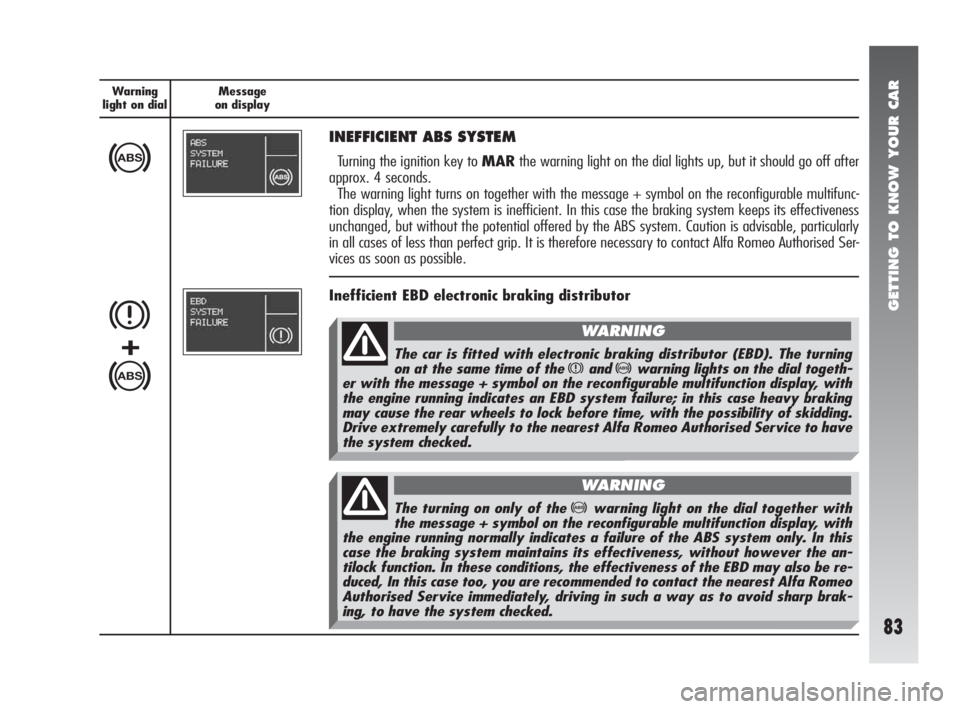
GETTING TO KNOW YOUR CAR
83
Warning
light on dialMessage
on display
>
INEFFICIENT ABS SYSTEM
Turning the ignition key to MARthe warning light on the dial lights up, but it should go off after
approx. 4 seconds.
The warning light turns on together with the message + symbol on the reconfigurable multifunc-
tion display, when the system is inefficient. In this case the braking system keeps its effectiveness
unchanged, but without the potential offered by the ABS system. Caution is advisable, particularly
in all cases of less than perfect grip. It is therefore necessary to contact Alfa Romeo Authorised Ser-
vices as soon as possible.
Inefficient EBD electronic braking distributor
x
>
+The car is fitted with electronic braking distributor (EBD). The turning
on at the same time of the xand>warning lights on the dial togeth-
er with the message + symbol on the reconfigurable multifunction display, with
the engine running indicates an EBD system failure; in this case heavy braking
may cause the rear wheels to lock before time, with the possibility of skidding.
Drive extremely carefully to the nearest Alfa Romeo Authorised Service to have
the system checked.
WARNING
The turning on only of the >warning light on the dial together with
the message + symbol on the reconfigurable multifunction display, with
the engine running normally indicates a failure of the ABS system only. In this
case the braking system maintains its effectiveness, without however the an-
tilock function. In these conditions, the effectiveness of the EBD may also be re-
duced, In this case too, you are recommended to contact the nearest Alfa Romeo
Authorised Service immediately, driving in such a way as to avoid sharp brak-
ing, to have the system checked.
WARNING
Page 94 of 291
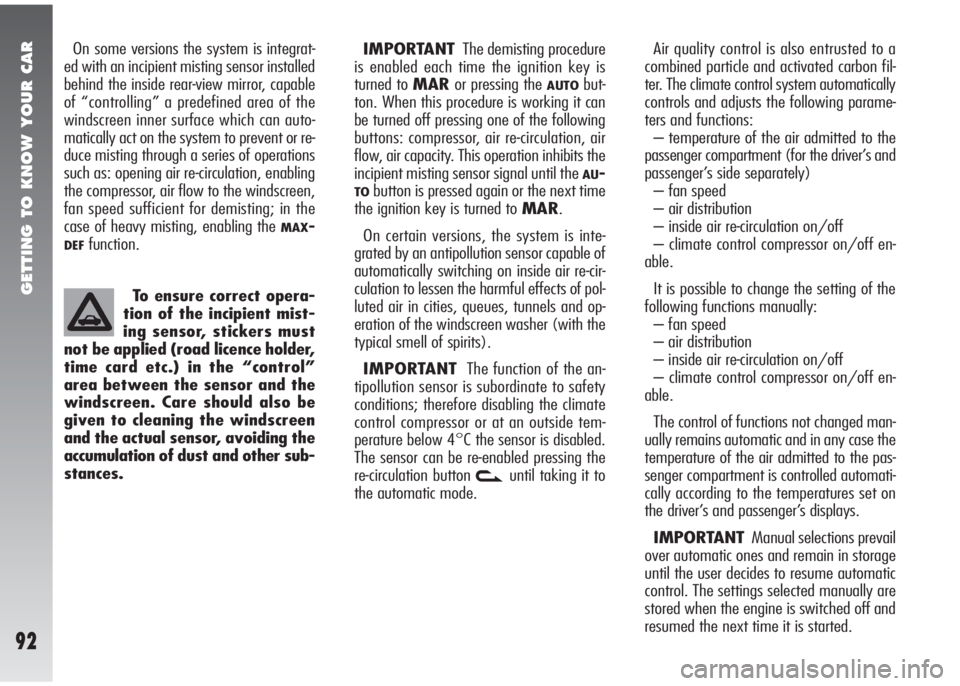
GETTING TO KNOW YOUR CAR
92
Air quality control is also entrusted to a
combined particle and activated carbon fil-
ter. The climate control system automatically
controls and adjusts the following parame-
ters and functions:
– temperature of the air admitted to the
passenger compartment (for the driver’s and
passenger’s side separately)
– fan speed
– air distribution
– inside air re-circulation on/off
– climate control compressor on/off en-
able.
It is possible to change the setting of the
following functions manually:
– fan speed
– air distribution
– inside air re-circulation on/off
– climate control compressor on/off en-
able.
The control of functions not changed man-
ually remains automatic and in any case the
temperature of the air admitted to the pas-
senger compartment is controlled automati-
cally according to the temperatures set on
the driver’s and passenger’s displays.
IMPORTANTManual selections prevail
over automatic ones and remain in storage
until the user decides to resume automatic
control. The settings selected manually are
stored when the engine is switched off and
resumed the next time it is started. To ensure correct opera-
tion of the incipient mist-
ing sensor, stickers must
not be applied (road licence holder,
time card etc.) in the “control”
area between the sensor and the
windscreen. Care should also be
given to cleaning the windscreen
and the actual sensor, avoiding the
accumulation of dust and other sub-
stances.IMPORTANTThe demisting procedure
is enabled each time the ignition key is
turned to MARor pressing the
AUTObut-
ton. When this procedure is working it can
be turned off pressing one of the following
buttons: compressor, air re-circulation, air
flow, air capacity. This operation inhibits the
incipient misting sensor signal until the
AU-
TObutton is pressed again or the next time
the ignition key is turned to MAR.
On certain versions, the system is inte-
grated by an antipollution sensor capable of
automatically switching on inside air re-cir-
culation to lessen the harmful effects of pol-
luted air in cities, queues, tunnels and op-
eration of the windscreen washer (with the
typical smell of spirits).
IMPORTANTThe function of the an-
tipollution sensor is subordinate to safety
conditions; therefore disabling the climate
control compressor or at an outside tem-
perature below 4°C the sensor is disabled.
The sensor can be re-enabled pressing the
re-circulation button
vuntil taking it to
the automatic mode. On some versions the system is integrat-
ed with an incipient misting sensor installed
behind the inside rear-view mirror, capable
of “controlling” a predefined area of the
windscreen inner surface which can auto-
matically act on the system to prevent or re-
duce misting through a series of operations
such as: opening air re-circulation, enabling
the compressor, air flow to the windscreen,
fan speed sufficient for demisting; in the
case of heavy misting, enabling the
MAX-
DEFfunction.
Page 96 of 291
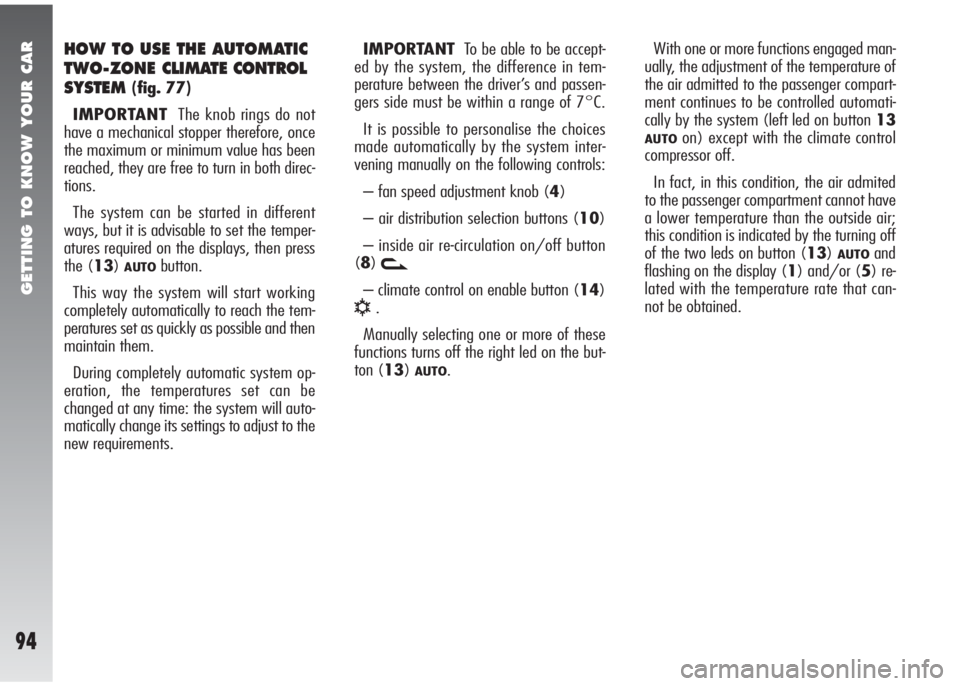
GETTING TO KNOW YOUR CAR
94
HOW TO USE THE AUTOMATIC
TWO-ZONECLIMATE CONTROL
SYSTEM
(fig. 77)
IMPORTANTThe knob rings do not
have a mechanical stopper therefore, once
the maximum or minimum value has been
reached, they are free to turn in both direc-
tions.
The system can be started in different
ways, but it is advisable to set the temper-
atures required on the displays, then press
the (13)
AUTObutton.
This way the system will start working
completely automatically to reach the tem-
peratures set as quickly as possible and then
maintain them.
During completely automatic system op-
eration, the temperatures set can be
changed at any time: the system will auto-
matically change its settings to adjust to the
new requirements.IMPORTANTTo be able to be accept-
ed by the system, the difference in tem-
perature between the driver’s and passen-
gers side must be within a range of 7°C.
It is possible to personalise the choices
made automatically by the system inter-
vening manually on the following controls:
– fan speed adjustment knob (4)
– air distribution selection buttons (10)
– inside air re-circulation on/off button
(8)v
– climate control on enable button (14)
√.
Manually selecting one or more of these
functions turns off the right led on the but-
ton (13)
AUTO.With one or more functions engaged man-
ually, the adjustment of the temperature of
the air admitted to the passenger compart-
ment continues to be controlled automati-
cally by the system (left led on button 13
AUTOon) except with the climate control
compressor off.
In fact, in this condition, the air admited
to the passenger compartment cannot have
a lower temperature than the outside air;
this condition is indicated by the turning off
of the two leds on button (13)
AUTOand
flashing on the display (1) and/or (5) re-
lated with the temperature rate that can-
not be obtained.
Page 110 of 291

GETTING TO KNOW YOUR CAR
108
HAND BRAKE (fig. 94)
The hand brake lever is located between
the two front seats.
To operate the brake when the vehicle is
stationary, pull lever (A) upwards, until the
required braking action is obtained.
When the ignition key is at MARthe
warning light on the instrument cluster
x
will come on.
fig. 94
A0A0490m
The display (B), in the tachometer shows
the positions during adjustment.
For correct adjustment, bear in mind the
following conditions:
– position 0: one or two people occupy-
ing the front seats
– position 1: five people;
– position 2: five people + load in the
boot;
– position 3: driver + maximum permis-
sible load all stowed in lug-
gage compartment
fig. 93
A0A0467m
HEADLIGHT AIMING DEVICE
(fig. 93)(excluding versions
with Xenon headlights)
The headlights should be aimed correctly
depending on the vehicle load.
To do this, use the rocker button (A), on
the plate at the side of the steering column:
– press the arrow on the button (
A), to
increase by one position (eg.: 0
➟1➟ 2
➟3);
– press the arrow on the button (
S), to
lower by one position (eg.: 3
➟2➟1
➟0).
Adjust the beams every time
the load carried changes.
WARNING
The wheels should be
locked after a few clicks of
the hand brake. If this does not oc-
cur contact Alfa Romeo Authorised
services to have the hand brake
adjusted.
WARNING
Page 119 of 291
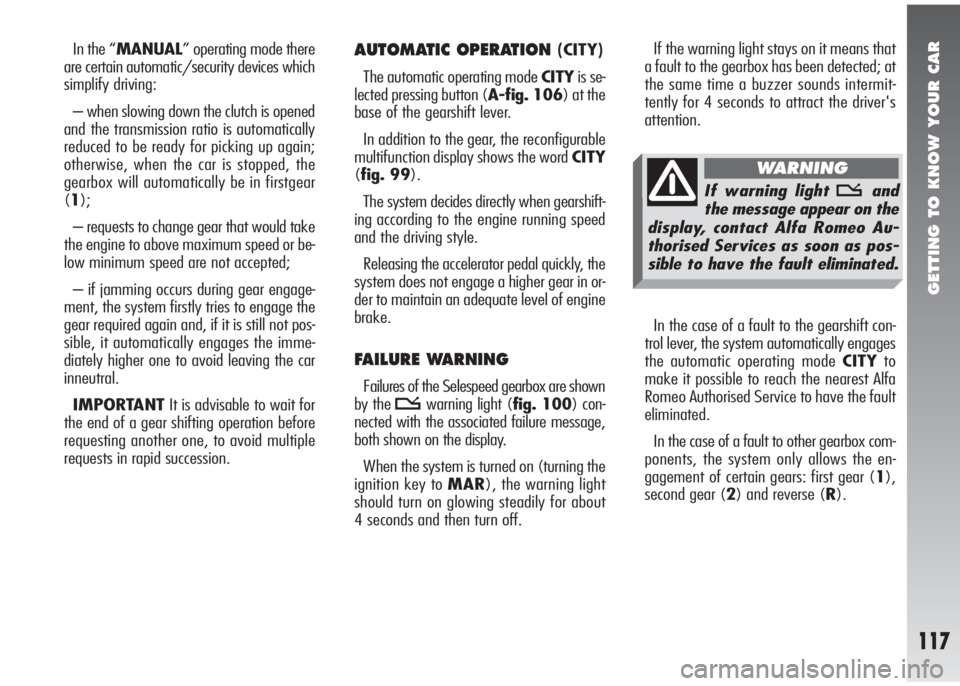
GETTING TO KNOW YOUR CAR
117
In the “MANUAL” operating mode there
are certain automatic/security devices which
simplify driving:
– when slowing down the clutch is opened
and the transmission ratio is automatically
reduced to be ready for picking up again;
otherwise, when the car is stopped, the
gearbox will automatically be in firstgear
(1);
– requests to change gear that would take
the engine to above maximum speed or be-
low minimum speed are not accepted;
– if jamming occurs during gear engage-
ment, the system firstly tries to engage the
gear required again and, if it is still not pos-
sible, it automatically engages the imme-
diately higher one to avoid leaving the car
inneutral.
IMPORTANTIt is advisable to wait for
the end of a gear shifting operation before
requesting another one, to avoid multiple
requests in rapid succession.AUTOMATIC OPERATION (CITY)
The automatic operating mode CITYis se-
lected pressing button (A-fig. 106) at the
base of the gearshift lever.
In addition to the gear, the reconfigurable
multifunction display shows the word CITY
(fig. 99).
The system decides directly when gearshift-
ing according to the engine running speed
and the driving style.
Releasing the accelerator pedal quickly, the
system does not engage a higher gear in or-
der to maintain an adequate level of engine
brake.
FAILURE WARNING
Failures of the Selespeed gearbox are shown
by the
twarning light (fig. 100) con-
nected with the associated failure message,
both shown on the display.
When the system is turned on (turning the
ignition key to MAR), the warning light
should turn on glowing steadily for about
4 seconds and then turn off.If the warning light stays on it means that
a fault to the gearbox has been detected; at
the same time a buzzer sounds intermit-
tently for 4 seconds to attract the driver's
attention.
In the case of a fault to the gearshift con-
trol lever, the system automatically engages
the automatic operating mode CITYto
make it possible to reach the nearest Alfa
Romeo Authorised Service to have the fault
eliminated.
In the case of a fault to other gearbox com-
ponents, the system only allows the en-
gagement of certain gears: first gear (1),
second gear (2) and reverse (R).
If warning light tand
the message appear on the
display, contact Alfa Romeo Au-
thorised Services as soon as pos-
sible to have the fault eliminated.
WARNING